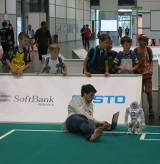A Comparison of Two Approaches for Vision and Self-Localization on a Mobile Robot
A Comparison of Two Approaches for Vision and Self-Localization on a Mobile Robot.
Daniel
Stronger and Peter Stone.
In IEEE International Conference on Robotics
and Automation, pp. 3915–3920, April 2007.
Download
[PDF]271.4kB [postscript]2.2MB
Abstract
This paper considers two approaches to the problem of vision and self-localization on a mobile robot. In the first approach, the perceptual processing is primarily bottom-up, with visual object recognition entirely preceding localization. In the second, significant top-down information is incorporated, with vision and localization being intertwined. That is, the processing of vision is highly dependent on the robot's estimate of its location. The two approaches are implemented and tested on a Sony Aibo ERS-7 robot, localizing as it walks through a color-coded test-bed domain. This paper's contributions are an exposition of two different approaches to vision and localization on a mobile robot, an empirical comparison of the two methods, and a discussion of the relative advantages of each method.
BibTeX Entry
@InProceedings{ICRA07,
author="Daniel Stronger and Peter Stone",
title="A Comparison of Two Approaches for Vision and Self-Localization on a Mobile Robot",
booktitle = "{IEEE} International Conference on Robotics and Automation",
location = "Rome",
month = "April",
year = "2007",
pages="3915--3920",
abstract = "This paper considers two approaches to the problem of
vision and self-localization on a mobile robot. In the first
approach, the perceptual processing is primarily bottom-up, with
visual object recognition entirely preceding localization. In
the second, significant top-down information is incorporated,
with vision and localization being intertwined. That is, the
processing of vision is highly dependent on the robot's estimate
of its location. The two approaches are implemented and tested
on a Sony Aibo ERS-7 robot, localizing as it walks through a
color-coded test-bed domain. This paper's contributions are an
exposition of two different approaches to vision and localization
on a mobile robot, an empirical comparison of the two methods,
and a discussion of the relative advantages of each method.",
}



